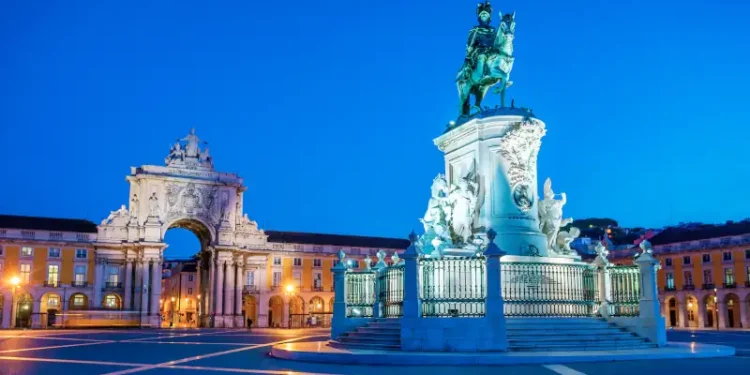Lisbon delivered a chilly evening on the first Tuesday in December 1979—well, chilly for Lisbon. I grew up in northern Minnesota so 14C (57F) felt like a summer evening to me.
My two-and-a-half weeks in Portugal were nearly over. Jetlag was a thing of the past and I enjoyed how the Portuguese ate dinner after 9 p.m. But who knew, I was about to officially fall in love with Portugal that night?
Our U.S. State Department Tourism Trade Mission finished up the day’s work late. Much had been accomplished. Everyone rushed to hotel rooms to freshen up for dinner—a dinner shrouded in secrecy and mystery. The itinerary merely indicated a “dinner event,” nothing else.
Questions went unanswered. None of our hosts shared anything about the event. We were only advised to wear comfortable shoes and bring a sweater, scarf, shawl, or such—it would be chilly where we were going.
I slipped into a white turtleneck shirt with The Lodge at Vail logo on it and grabbed my sensible navy wool blazer. After considering a scarf I decided that I wouldn’t need it—and indeed, I didn’t. I bolted for the elevator and boarded the shuttle bus with about a minute to spare.
The dinner secret finally was unveiled as we arrived at the Escola Portuguesa da Arte Equestre (The Portuguese School of Equestrian Art).
We were ushered to our box where a beautiful banquet table was set. All of our seats faced the arena. Linen table cloths, glimmering silverware, candelabras, and beautiful fresh flowers. We had stepped back in time…
It was the 18th century. We were guests of the royal court of Portugal about to enjoy a Royal Lusitano Horse Show. Lone chairs in the arena audience were occupied quietly by people who waited for the show to begin—all the while enviously glancing at the fortunate group seated next to the opulent banquet table.
It was already a bit after 9 p.m. Ready for dinner, I noticed my five wine glasses. Oh my, we were about to be wined and dined while watching an amazing equestrian show.
The riders wore formal costumes of the 18th century. There were black felt tricorns on everyone’s head. Long tailcoats in burgundy velvet with black collars and gold braided trim seemed to have been transported through the centuries. The rider’s tan equestrian trousers were tucked into supple black leather gaiters above their shoes. I recall thinking that the outfit would be stunning to get married in.
The show featured classical riding exercises and choreography performed by expert riders and magnificent Lusitano horses. The Lusitanos performed Baroque exercises, such as ‘airs above the ground’ accompanied by music, similar to a ballet. These classical riding exercises and choreography were practiced between the 16th and 19th centuries on festive occasions. Thankfully these traditions have been preserved since the end of the monarchy to let us relive the courtly times of Portugal.
The Portuguese School of Equestrian Art was the successor to the former Royal Riding Arena, the equestrian academy of the Portuguese Court, which closed at the end of the 19th century. We journeyed back through Portugal’s history, experiencing moments that have been immortalized in the beauty of the Lusitano horses of the Alter Stud Farm, founded in 1748 by King John V.
Our hosts explained that during the Salazar dictatorship, in an amazing act of defiance and bravery, several Lusitano horse breeders worked together to take stallions and mares to Ilha de Monte Farinha (an island located in the Aveiro Lagoon near the entrance to the Atlantic Ocean) to save the breed. Those who love and admire Lusitano horses owe a debt of gratitude to these men.
Did you know that the Lusitano horse is recognized as the oldest saddle horse breed in the world, with roots going back more than 5,000 years to the Portuguese area of the Iberian Peninsula?
Drawings of horses who amazingly look like the modern Lusitano are found on the Escoural Caves of Portugal’s Alentejo and date back to 17,000 BC.
Homo sapiens arrived in Portugal 35,000 years ago and began riding at least 5,000 years ago; long before the famous horsemen of Greece. The Phoenicians discovered Portugal and named it Lusitania—so of course the magnificent horses were named Lusitanos.
Originally bred as a horse of war and kings, Lusitano horses always stood out for their courage, agility, and nobility. Legends claim their agility is attributed to the earliest Lusitanos surviving predators by grazing near bulls in ancient Portugal.
Over the centuries, the Lusitano earned its place in arenas, classical riding schools, and today is a leader on the international stage of dressage and working equitation.
More than just a horse, the Lusitano is a living heritage of Portugal, admired for its elegance, docility, and versatility.
Somewhere during that 1979 December evening I realized I wanted to live in Portugal—and I had to get to know someone who rode a Lusitano horse.
A few days later our State Department’s visit came to an end. The inaugural liaison work was finished. We enjoyed a final banquet with our hosts. Everyone delivered farewell toasts. I stood with tears in my eyes to say my thank-yous to our new-found friends… and surprised myself as I announced that I planned to retire in Portugal. I definitely would return.
My dad often told my brothers and I with a chuckle, “The universe listens and delivers when we share what we plan to do out loud.” He was right.
My husband Jeff and I moved to Portugal 41 years after my declaration during that toast. To further endorse dad’s whimsical saying—we have a new friend who owns a Lusitano horse at a stable in Sintra. Our friend divides her time between the U.S. and Portugal. How nice is that?
As Jeff and I often remind ourselves, “A vida é boa” (Life is good), especially here in Portugal, where Lusitano horses reside, too.
Sincerely,
Joch Woodruff
Portugal Circle Liaison











